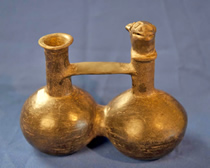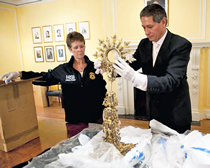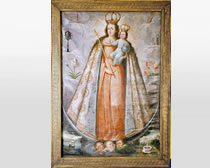 |
| ICE: Artifact returned to Peru on July 12. |
United States Immigration and Customs Enforcement (ICE) reported no arrests or indictments during a repatriation ceremony yesterday that returned stolen and smuggled cultural objects to Peru.
In a press statement, ICE’s Homeland Security Investigations (HSI) said that it mounted an “undercover Internet operation” and recovered the artifacts “in five separate investigations in . . . New York; West Virginia; Wilmington, Delaware; and Austin and Houston, Texas.” HSI concluded that the objects were illegally imported into the United States in violation of U.S. customs laws after having been illegally removed from Peru.
 |
| ICE agent watching over a monstrance. |
With assistance from the U.S. Department of Justice and INTERPOL, HSI seized and sent to Peru nine 18th century religious paintings, pre-Columbian pottery, an Andean textile, a monstrance, a Moche jar, and a tumi blade.
ICE Director John Morton observed that “[t]he plundering of cultural property is one of the oldest forms of organized cross-border crime and has become a world-wide phenomenon that transcends frontiers.” Deputy Attorney General James Cole added, “Like other criminal acts, cultural property crimes are borderless and require a coordinated law enforcement response among countries…. [The objects] were stolen by those whose selfish acts and greed sought to deprive a people and the public of their cultural treasures.“
No mention was made during Thursday’s public ceremony held in Washington, DC of any arrests, grand jury investigations, indictments, or continued law enforcement probes into the alleged criminal activity. HSI’s seize and send policy has been critiqued because of its disproportionate focus on the repatriation of cultural objects over needed efforts to deter transnational cultural heritage crime by prosecuting antiquities traffickers when they violate U.S. law.
HSI outlined details of its investigation in its press statement:
“Of the objects returned July 12, two of the Cusco oil paintings – Saint Ignatius of Loyola, and Virgin and Child – were sold at an auction house in Austin. Seven other Peruvian antique paintings were being sold from a Houston gallery. The pre-Columbian Chimu-Inca whistling pot and Andean textile were being sold on eBay. In an undercover Internet operation, HSI special agents in West Virginia targeted sellers of illicit pre-Columbian artifacts operating from this Internet site. The monstrance was listed for sale at Christie’s auction house in New York and HSI special agents discovered it was consigned by an art collector associated with museums in Puerto Rico and Denver. HSI’s investigation revealed that the monstrance had been stolen from Saint Stephen the Martyr, a small Catholic church in Yaurisque, located in the Cusco region of Peru. The Moche ceramic jar and the bronze ceremonial knife were consigned by an estate trust in order to be sold at an auction house in Madison, N.J., and necessitated grand jury subpoenas issued by the U.S. Attorney’s Office for the District of Delaware.”
 Assistant United States Attorney David Hall from the Delaware U.S. Attorney’s Office was responsible for investigating two of the Cusco school paintings involved in the case, according to a statement released by that office. An image of one of the paintings appears at right. Hall is a 2010 SAFE (Saving Antiquities for Everyone) Beacon Award winner.
Assistant United States Attorney David Hall from the Delaware U.S. Attorney’s Office was responsible for investigating two of the Cusco school paintings involved in the case, according to a statement released by that office. An image of one of the paintings appears at right. Hall is a 2010 SAFE (Saving Antiquities for Everyone) Beacon Award winner.
The repatriation ceremony comes one month after the United States renewed import controls covering Peruvian cultural property determined to be in jeopardy from plunder.
©2010-2022 Cultural Heritage Lawyer Rick St. Hilaire. Content discussing cultural heritage law, art law, looted antiquities, stolen artifacts, and museum risk management that is general information only, not legal advice.


 Assistant United States Attorney David Hall from the Delaware U.S. Attorney’s Office was responsible for investigating two of the Cusco school paintings involved in the case, according to a statement released by that office. An image of one of the paintings appears at right. Hall is a 2010 SAFE (Saving Antiquities for Everyone) Beacon Award winner.
Assistant United States Attorney David Hall from the Delaware U.S. Attorney’s Office was responsible for investigating two of the Cusco school paintings involved in the case, according to a statement released by that office. An image of one of the paintings appears at right. Hall is a 2010 SAFE (Saving Antiquities for Everyone) Beacon Award winner.
